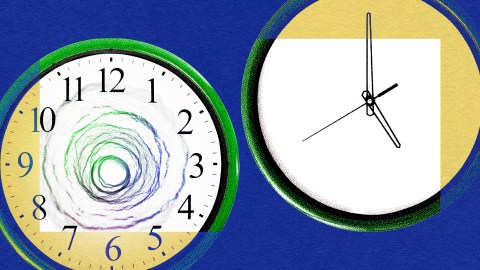The physical and philosophical problem of time

- The more we think about time the more mysterious it becomes.
- We can talk of cognitive time and the time of physics, but they seem quite different. Perhaps there is no single definition of time.
- When we extend time to cosmology, it seems that the Universe has its own universal clock, with a beginning and an end enshrined in mystery.
“Time doesn’t stop.” We all say (and feel) this and yet we hardly ever stop to think about the meaning of time and its passage. Time is one of those deeply stirring topics, the kind we tend to push aside and prefer to forget. After all, to think about time and how fast it passes leads quickly to thoughts about death. This is the essence of the human predicament, to have awareness of the passage of time, to know that our days on this planet and in this life are finite.
Past, present, future
Still, some of us do think about the nature of time, and physicists, far from being morbid folks, do that a lot. We tend to split time into three segments, past, present, and future. As everyone knows, past is what comes before the present, what “was,” while the future is what comes next, what “will be.” Even if this split seems obvious, it isn’t. It’s more of an operational definition, which, under further analysis, becomes quite nebulous. We need the present to define the past and the future. But what, exactly, is the present?
Whatever is defined in time needs to have duration. We can look back at our lives and call that expanse of time the past. We can look forward and call what’s to come the future. But what is the in-between demarcation point? The present is as thin as it can be. In fact, mathematically, we define the now as a single point in time. This point is an abstraction and, being a point, it has no duration. Ergo, mathematically, the present is a point in time with no duration: The present doesn’t exist, or at least it doesn’t have duration in the mathematical definition of time!
On the other hand, we do have a sense of the present. Our minds create the feeling of duration so that we can attribute reality to what we call the “now.” (Here’s a TEDx talk addressing how this works cognitively.)
Time is, essentially, a measure of change. When all remains the same, time is unnecessary. That’s why there is no time in Paradise: no change, no time. But if we need to describe the motion of a car, or of the Moon around the Earth, or of a chemical reaction, or of a baby growing into a toddler, we need time.
Einstein’s view of time
Near the end of the 17th century, Isaac Newton defined what we call absolute time, a time that just flows steadily like a stern river and is the same for all observers — that is, people or instruments making measurements of things moving about. Early in the 20th century, Albert Einstein argued that this notion of time is a crude approximation to what really goes on. Time and duration, he said, depend on the relative motion between observers.
A famous example is the definition of simultaneity, when two or more events are said to happen at the very same time. Einstein explained that two events that happen simultaneously for an observer A happen at different times for an observer B in motion with respect to A.
Inspired by the train station in front of his home in Bern, Einstein used trains to illustrate his revolutionary idea. Imagine A is standing by the station as a train goes by. When the train is exactly halfway through, two lightning strikes hit its front and back. Observer A measures the time it takes for light from both strikes to get to her and concludes they arrived at the same time: They were simultaneous.
Observer B, however, was inside the moving train. To him, the lightning strike that hit the front of the train arrived to him before the one hitting the back. The reason is simple, Einstein suggested: Since light travels at the same speed no matter what (and this was his revolutionary assumption), and the train is moving forward, the lighting hitting the front would have a shorter distance to travel and, hence, arrived at observer B before the lightning that hit the back, which had to catch up with the moving train.
Now, for normal train speeds, the difference is ridiculously small. That is why we do not notice such things in ordinary life. And that is why Newton’s approximation of absolute time, irrespective of the observer’s motion, works for everyday stuff. But as speeds increase and approach the speed of light, the differences become noticeable. This effect has been measured countless times in the laboratory and in other experiments, confirming Einstein’s special theory of relativity. Time, and its perception, is indeed quite subtle.
Einstein didn’t stop there. Ten years later, in 1915, he published his general theory of relativity, showing that once we include accelerated motions, we must rethink gravity and the nature of space and time altogether. In a spectacular display of intuition, Einstein realized that gravity mimics acceleration (like when you go up or down in a fast elevator and feel your “weight” change). He realized that to understand accelerated motion with a constant speed of light was equivalent to describing gravity as the bending of space and time. (“Bent” time means that gravity affects the passage of time.)
Very roughly, whenever there is a gravitational pull, it gets harder to move away from it. Even light is affected, not in its speed but in its wave properties, becoming stretched out as it tries to move away from a region with strong gravity, like near a star and, more dramatically, near a black hole. If you think of a light wave as a kind of clock (you can count how many wave crests pass by you per second, for example), you see that gravity decreases the number of crests going by. The stronger gravity is, the fewer crests you will count. This kind of reasoning applies to any sort of clock, and it translates into saying that gravity slows time down. (For more, you can check this link.)
The significance of the passage of time
So, both in what we can call cognitive time (the subjective feeling we have of time passing) and in the time of the physicists, there are many subtleties. A famous debate took place in 1922 between the philosopher Henri Bergson and Einstein to discuss these two apparently conflicting notions of time. If anything, the discussion caused the gulf between the sciences and the humanities to grow even more. Perhaps a useful compromise is not to box time into a single definition but to think of it contextually, as it serves different purposes.
Things get even more nebulous when we think about the origin of the Universe. The word “origin” already says it: It is the moment in time when the Universe as we know it came to be; essentially, when time began to tick. How that happened remains a mystery, one that brings forth a whole slew of conceptual difficulties.
There is, then, yet another kind of clock, a universal, or cosmic clock that started to tick at the Big Bang some 13.8 billion years ago, and, if what we know now of the Universe and its material contents is any indication, seems poised to keep on going for as long as we can imagine. However, and to make things more interesting, given that what we can say about the distant future depends on what we know of the properties of the Universe in the distant future, we can say very little with certainty. Existence, from cosmic to human, is bracketed at both ends by mystery.





